Experimental Study for Wave-Induced Pore-Water Pressures in a Porous Seabed around a Mono-Pile
Abstract
:1. Introduction
2. Physical Modeling
2.1. Experimental Setup
2.2. Properties of Seabed Sediments
2.3. Wave Conditions
2.4. Test Procedure
- (1)
- Placement of the mono-pile and instruments: 23 pressure transducers and four wave height gauges were installed in the locations specified in Figure 3. Since the pore-pressure transducers are equipped with sand filters, they must be submerged in water for at least 24 h to ensure that the air is completely exhausted.
- (2)
- Filling the sediment tank: Prior to the experiments, the large amount of sand was first poured into the soil-mixture tank slowly, and water was gradually added to the tank with continuous and thorough stirring until the mixture reached a homogeneous liquid state. The mixture was then pumped into the test section, where it was left to consolidate for at least three days. Finally, a soil layer with a thickness of about 1.0 m was produced.
- (3)
- Filling the water tank: The water was poured into the water tank slowly until the water depth reached 0.6 m.
- (4)
- The wavemaker was switched on.
- (5)
- Sampling the statistics of pore pressure and wave height: The duration of data collection was at least 240 s after the full development of the oscillatory soil response in the sandy seabed and the equilibrium state was reached.
- (6)
- The wavemaker was switched off.
- (7)
- Steps 4–6 were repeated for the next test.
3. Wave Profiles near the Mono-Pile and Dynamic Wave Pressures on the Mono-Pile
4. Pore-Water Pressures in the Seabed
4.1. In front of the Mono-Pile
4.2. Behind the Pile
4.3. Around the Pile
4.4. Beneath the Center of the Pile
5. Conclusions
- The wave is affected by the presence of the pile and the waveform is deformed near the pile due to diffraction and reflection, which will have an effect on the response of the seabed. The wave pressure on the front of the pile is greater than that on the side of the pile.
- The seabed dynamic responses are more pronounced near the surface (in the region above 30 cm deep), and the rate of pore pressure attenuation gradually slows down. For the region below 0.3 m, the response is much smaller, and the influence of the wave conditions becomes insignificant.
- In general, the pore-water pressure along the surface of the mono-pile increases as the wave height and wave period increase, which is related to wave energy.
- The presence of the pile has an obvious effect on the response of the seabed. The experimental results suggest that the spatial distribution of pore pressure near the pile will change with different wave periods, which can be attributed to wave diffraction around the pile, while the wave height only has a significant effect on the amplitude.
- The pore-pressure amplitude of topsoil ( m) in front of the mono-pile () is larger, while beneath the pile ( m), the largest pore pressures occur behind the pile (). Pore pressure is produced by the wave load on the seabed, but the propagation of pore pressure is also affected by the structure.
Author Contributions
Funding
Conflicts of Interest
References
- Sumer, B.M. Liquefaction around Mainre Structures; World Scientific: Hackensack, NJ, USA, 2014. [Google Scholar]
- Jeng, D.S. Mechanics of Wave-Seabed-Structure Interactions: Modelling, Processes and Applications; Cambridge University Press: Cambridge, UK, 2018. [Google Scholar]
- Zen, K.; Yamazaki, H. Mechanism of wave-induced liquefaction and densification in seabed. Soils Found. 1990, 30, 90–104. [Google Scholar] [CrossRef]
- Sumer, B.M.; Fredsoe, J. The Mechanics of Scour in the Marine Environment; World Scientific Publishing Co. Pte. Ltd.: Singapore, 2002. [Google Scholar]
- Jeng, D.S. Porous Models for Wave-Seabed Interactions; Springer: Berlin, Germany, 2013. [Google Scholar]
- Tzang, S.Y.; Ou, S.H. Laboratory flume studies on monochromatic wave-fine sandy bed interactions: Part 1. Soil fluidization. Coast. Eng. 2006, 53, 965–982. [Google Scholar] [CrossRef]
- Wang, L.; Pan, D.; Pan, C.; Hu, J. Experimental investigation on wave-induced response of seabed. China Civil Eng. J. 2007, 40, 101–109. (In Chinese) [Google Scholar]
- Kirca, V.S.O.; Sumer, B.M.; Fredsøe, J. Influence of clay content on wave-induced liquefaction. J. Waterw. Port Coast. Ocean Eng. ASCE 2014, 140, 04014024. [Google Scholar] [CrossRef]
- Biot, M.A. General theory of three-dimensional consolidation. J. Appl. Phys. 1941, 26, 155–164. [Google Scholar] [CrossRef]
- Yamamoto, T.; Koning, H.; Sellmeijer, H.; Hijum, E.V. On the response of a poro-elastic bed to water waves. J. Fluid Mech. 1978, 87, 193–206. [Google Scholar] [CrossRef]
- Madsen, O.S. Wave-induced pore pressures and effective stresses in a porous bed. Géotechnique 1978, 28, 377–393. [Google Scholar] [CrossRef]
- Hsu, J.R.C.; Jeng, D.S. Wave-induced soil response in an unsaturated anisotropic seabed of finite thickness. Int. J. Numer. Anal. Methods Geomech. 1994, 18, 785–807. [Google Scholar] [CrossRef]
- Li, X.J.; Gao, F.P.; Yang, B.; Zang, J. Wave-induced pore pressure response and soil liquefaction around pile foundation. Int. J. Offshore Polar Eng. 2011, 21, 233–239. [Google Scholar]
- Chang, K.T.; Jeng, D.S. Numerical study for wave-induced seabed response around offshore wind turbine foundation in Donghai offshore wind farm, Shanghai, China seabed response around mono-pile foundation: Donghai Offshore Wind Farm in China. Ocean Eng. 2014, 85, 32–43. [Google Scholar] [CrossRef]
- Lin, Z.; Pokrajac, D.; Guo, Y.; Jeng, D.S.; Tang, T.; Rey, N.; Zheng, J.; Zhang, J. Investigations of nonlinear wave-induced seabed response around mono-pile foundation. Coast. Eng. 2017, 121, 197–211. [Google Scholar] [CrossRef]
- Sui, T.; Zhang, C.; Guo, Y.; Zheng, J.; Jeng, D.; Zhang, J.; Zhang, W. Three-dimensional numerical model for wave-induced seabed response around mono-pile. Ships Offshore Struct. 2016, 11, 667–678. [Google Scholar] [CrossRef]
- Sui, T.T.; Zhang, C.; Guo, Y.; Jeng, D.S.; Zheng, J.; Gao, Y. Wave-induced seabed residual liquefaction around a mono-pile foundation with various embedded depth. Ocean Eng. 2019, 172, 157–173. [Google Scholar] [CrossRef]
- Zhang, Y.; Liao, C.; Chen, J.; Tong, D.; Wang, J. Numerical analysis of interaction between seabed and mono-pile subjected to dynamic wave loadings considering the pile rocking effect. Ocean Eng. 2018, 155, 173–188. [Google Scholar] [CrossRef]
- Zhu, B.; Ren, J.; Ye, G.L. Wave-induced liquefaction of the seabed around a single pile considering pile-soil interaction. Mar. Georesour. Geotechnol. 2018, 36, 150–162. [Google Scholar] [CrossRef]
- Chowdhury, B.; Dasari, G.R.; Nogami, T. Laboratory study of liquefaction due to wave-seabed interacton. J. Geotech. Geoenviron. Eng. ASCE 2006, 132, 841–851. [Google Scholar] [CrossRef]
- Liu, B.; Jeng, D.S.; Ye, G.; Yang, B. Laboratory study for pore pressures in sandy deposit under wave loading. Ocean Eng. 2015, 106, 207–219. [Google Scholar] [CrossRef]
- Sassa, S.; Sekiguchi, H. Wave-induced liquefaction of beds of sand in a centrifuge. Géotechnique 1999, 49, 621–638. [Google Scholar] [CrossRef]
- Tsui, Y.; Helfrich, S.C. Wave-induced pore pressures in submerged sand layer. J. Geotech. Eng. ASCE 1983, 109, 603–618. [Google Scholar] [CrossRef]
- Sumer, B.M.; Hatipoglu, F.; Fredsøe, J.; Sumer, S.K. The sequence of sediment behaviour during wave-induced liquefaction. Sedimentology 2006, 53, 611–629. [Google Scholar] [CrossRef]
- Sumer, B.M.; Kirca, V.S.O.; Fredsøe, J. Experimental Validation of a Mathematical Model for Seabed Liquefaction Under Waves. Int. J. Offshore Polar Eng. 2012, 22, 133–141. [Google Scholar]
- Qi, W.G.; Gao, F.P. Physical modelling of local scour development around a large-diameter monopile in combined waves and current. Coast. Eng. 2014, 83, 72–81. [Google Scholar] [CrossRef]
- Qi, W.; Gao, F. Equilibrium scour depth at offshore monopile foundation in combined waves and current. Sci. China Technol. Sci. 2014, 57, 1030–1039. [Google Scholar] [CrossRef] [Green Version]
- Le M’ehaut’e, B.L. An Introduction to Hydrodynamics and Water Waves; Springer: Berlin/Heidelberg, Germany, 1976. [Google Scholar]
- Okusa, S. Wave-induced stress in unsaturated submarine sediments. Géotechnique 1985, 35, 517–532. [Google Scholar] [CrossRef]

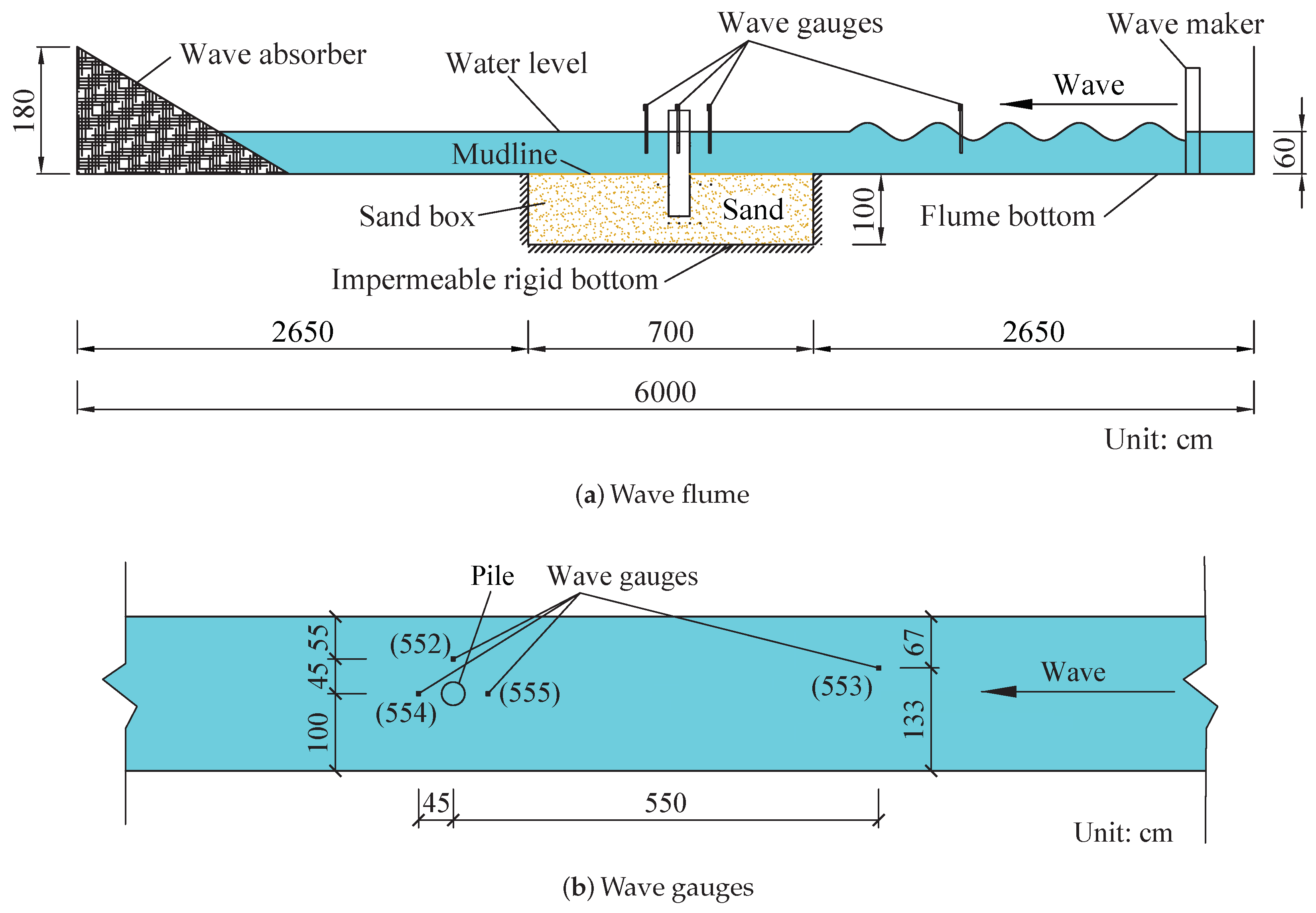
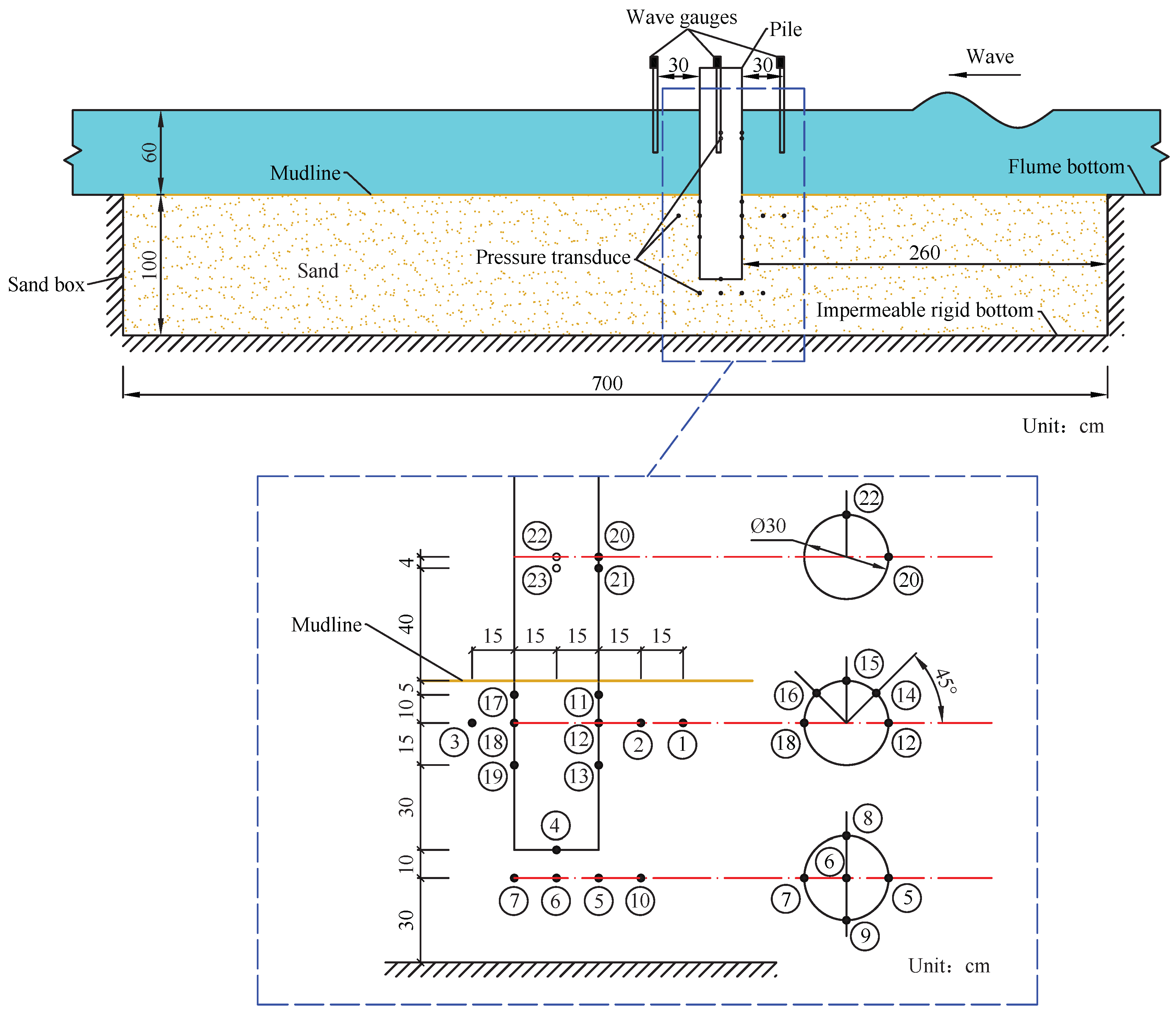
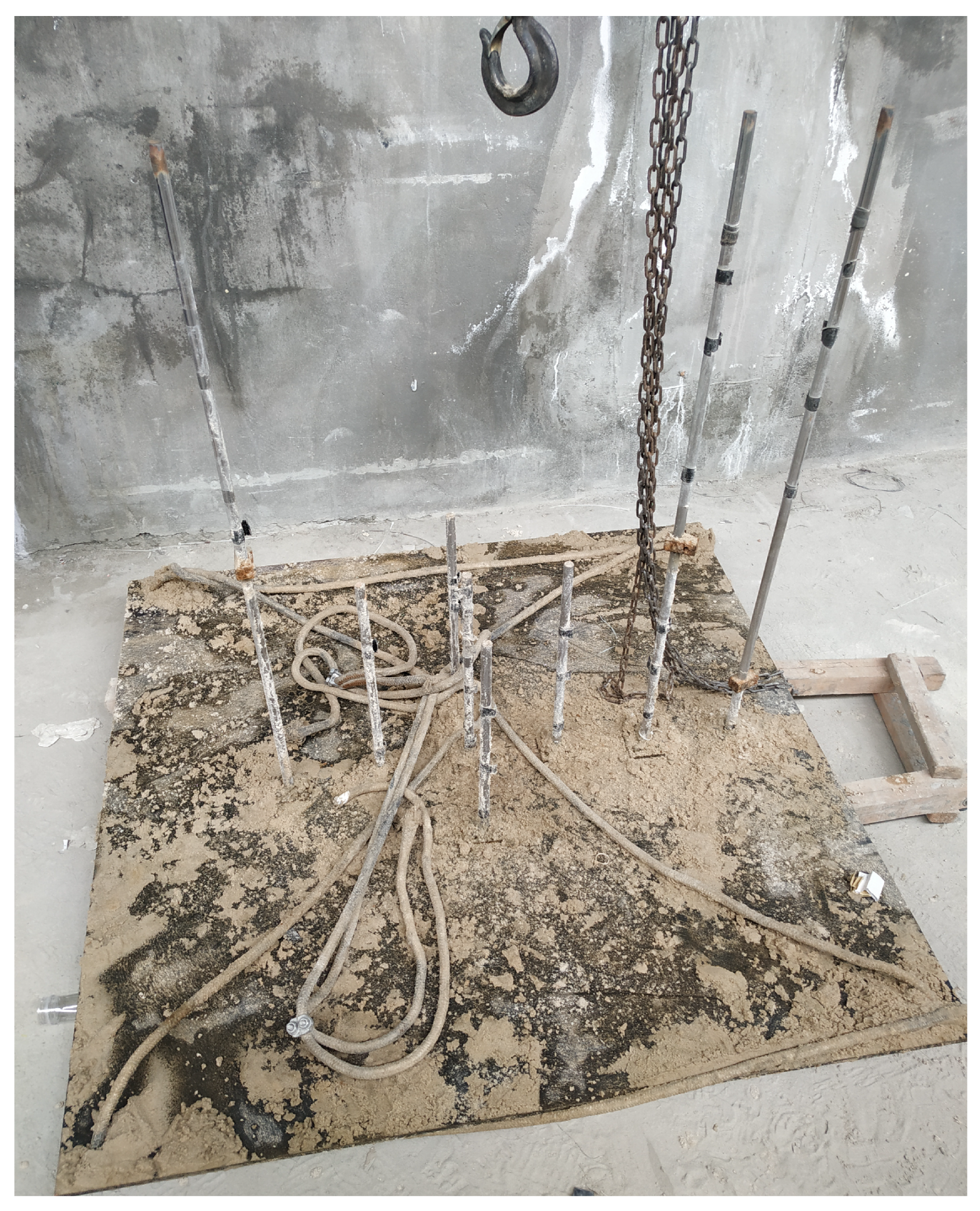
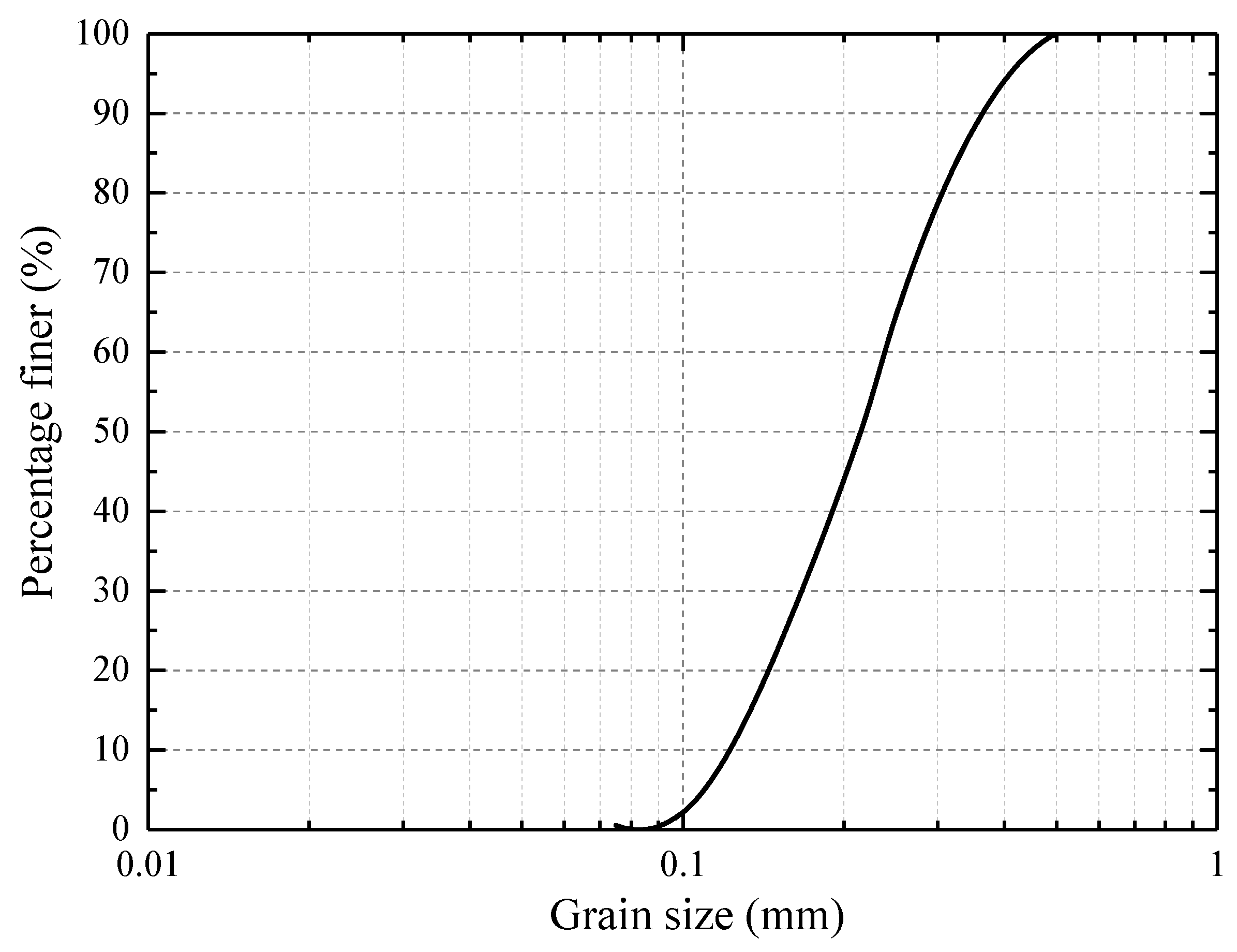
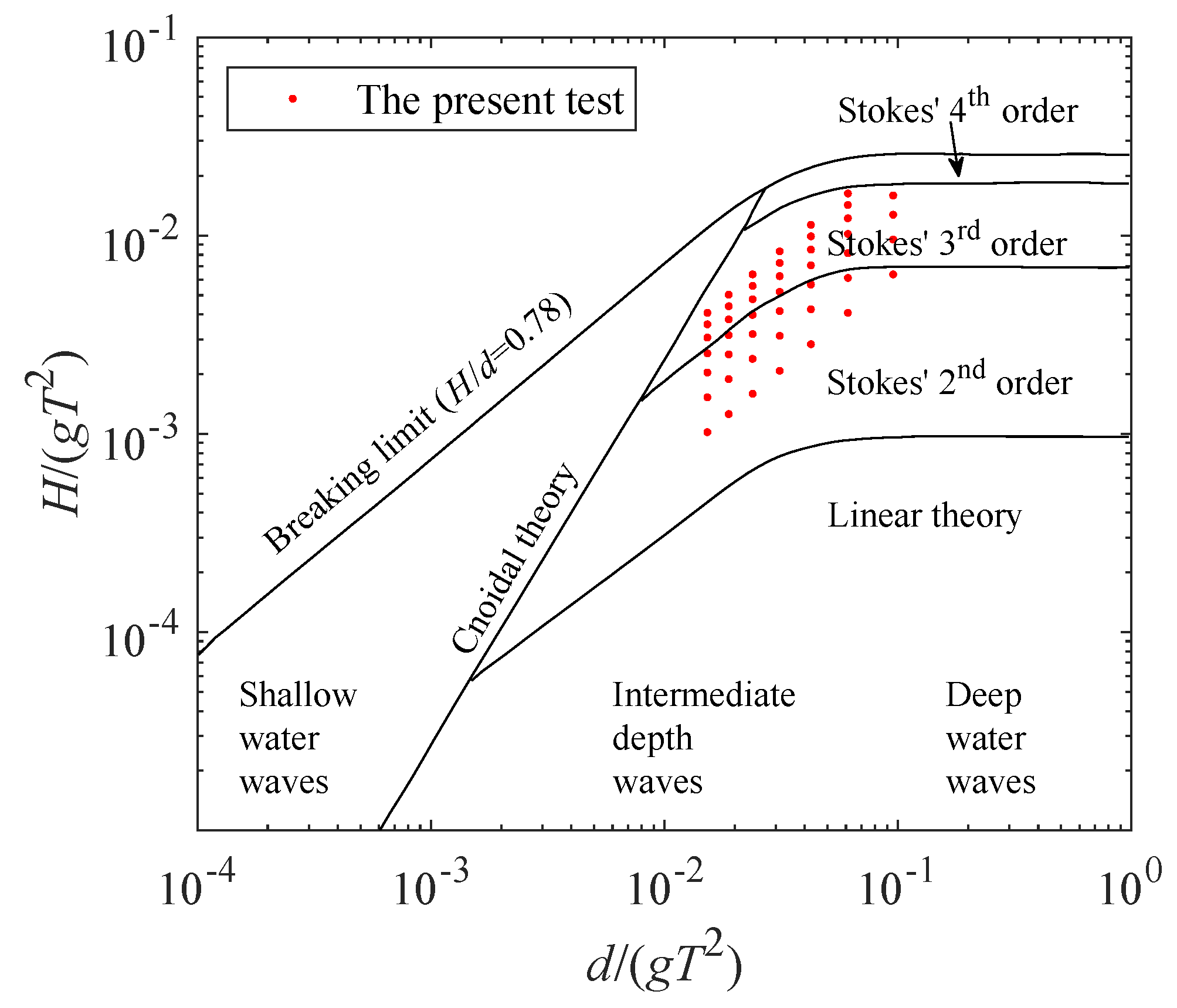
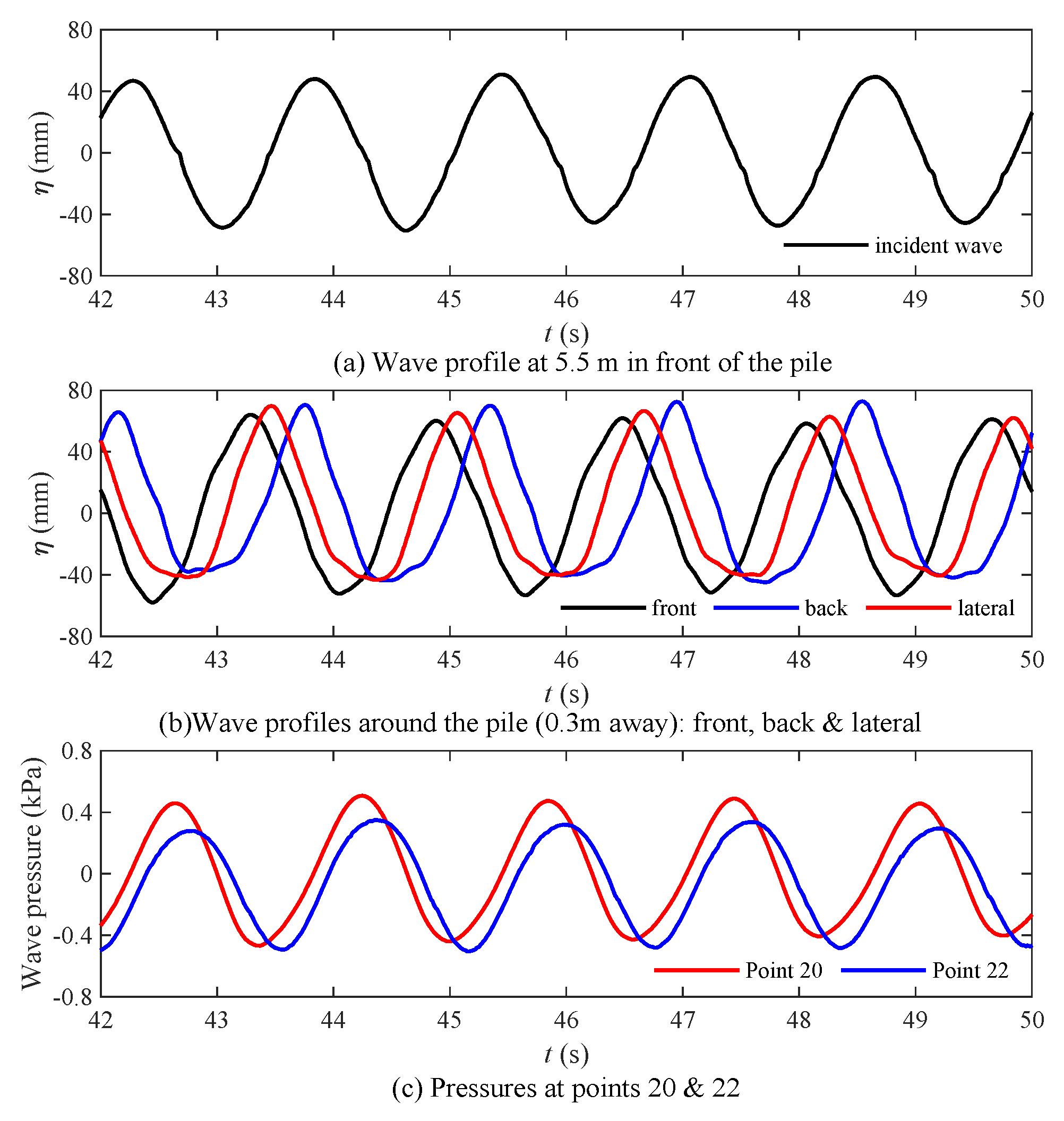
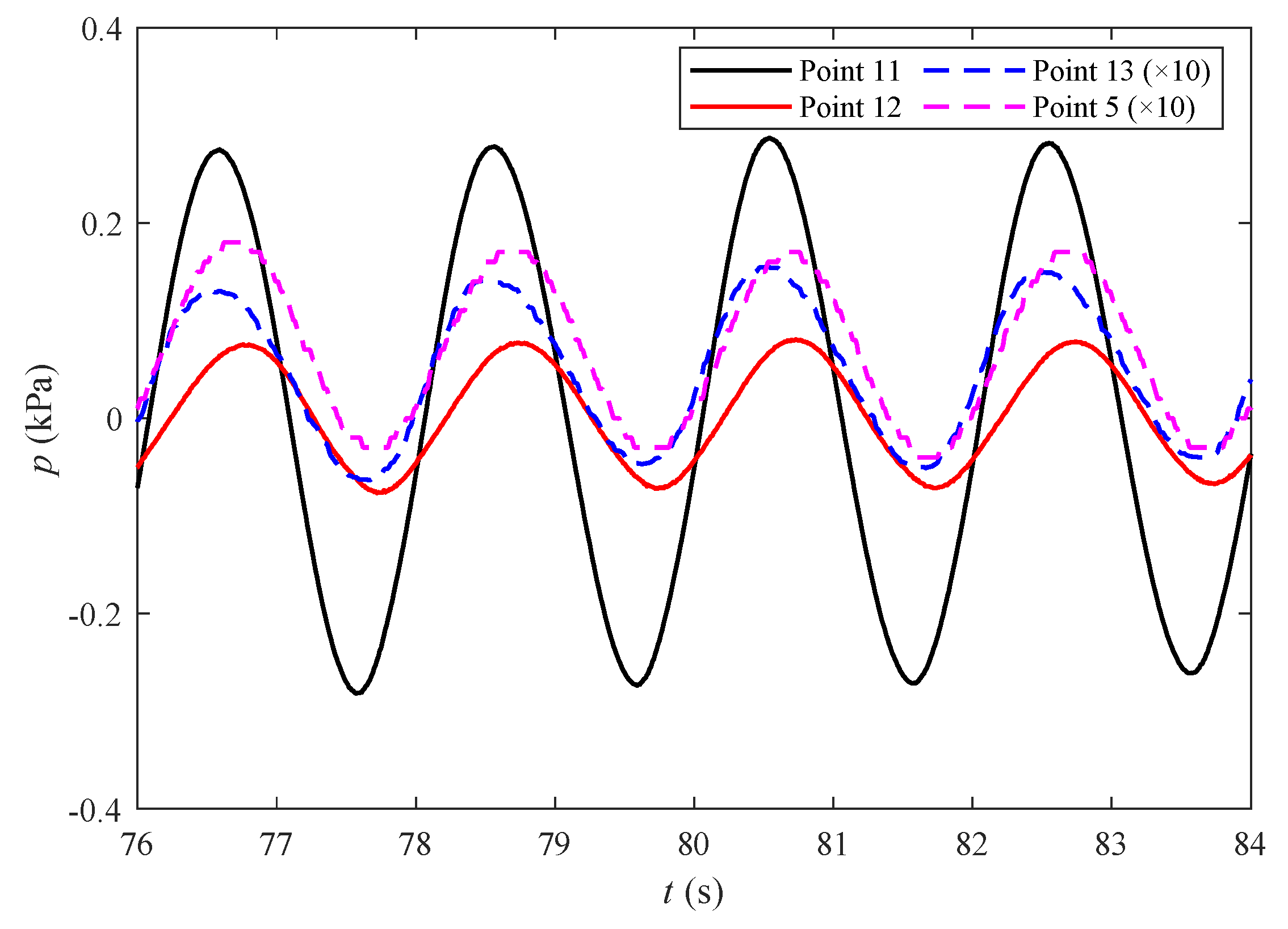
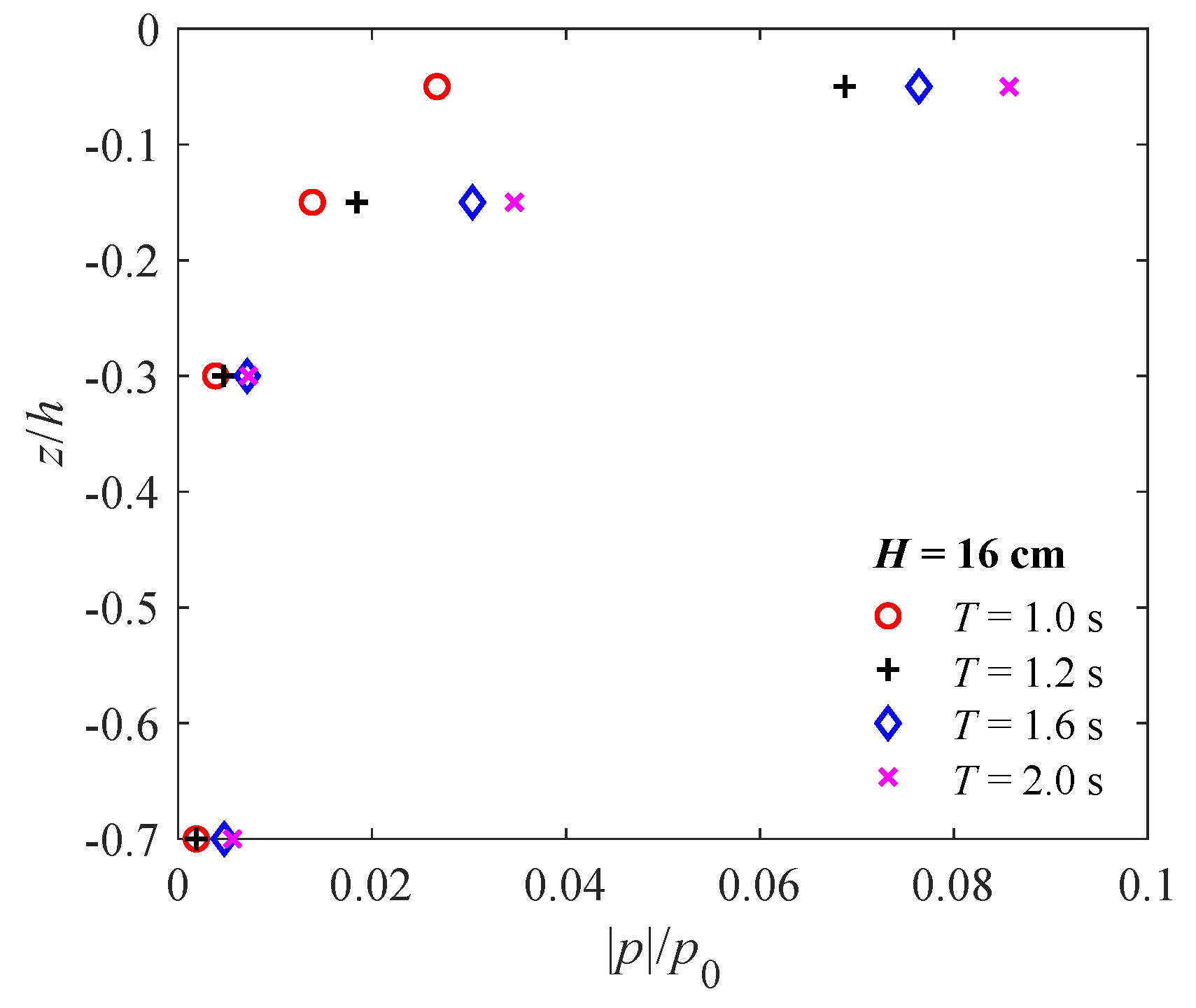
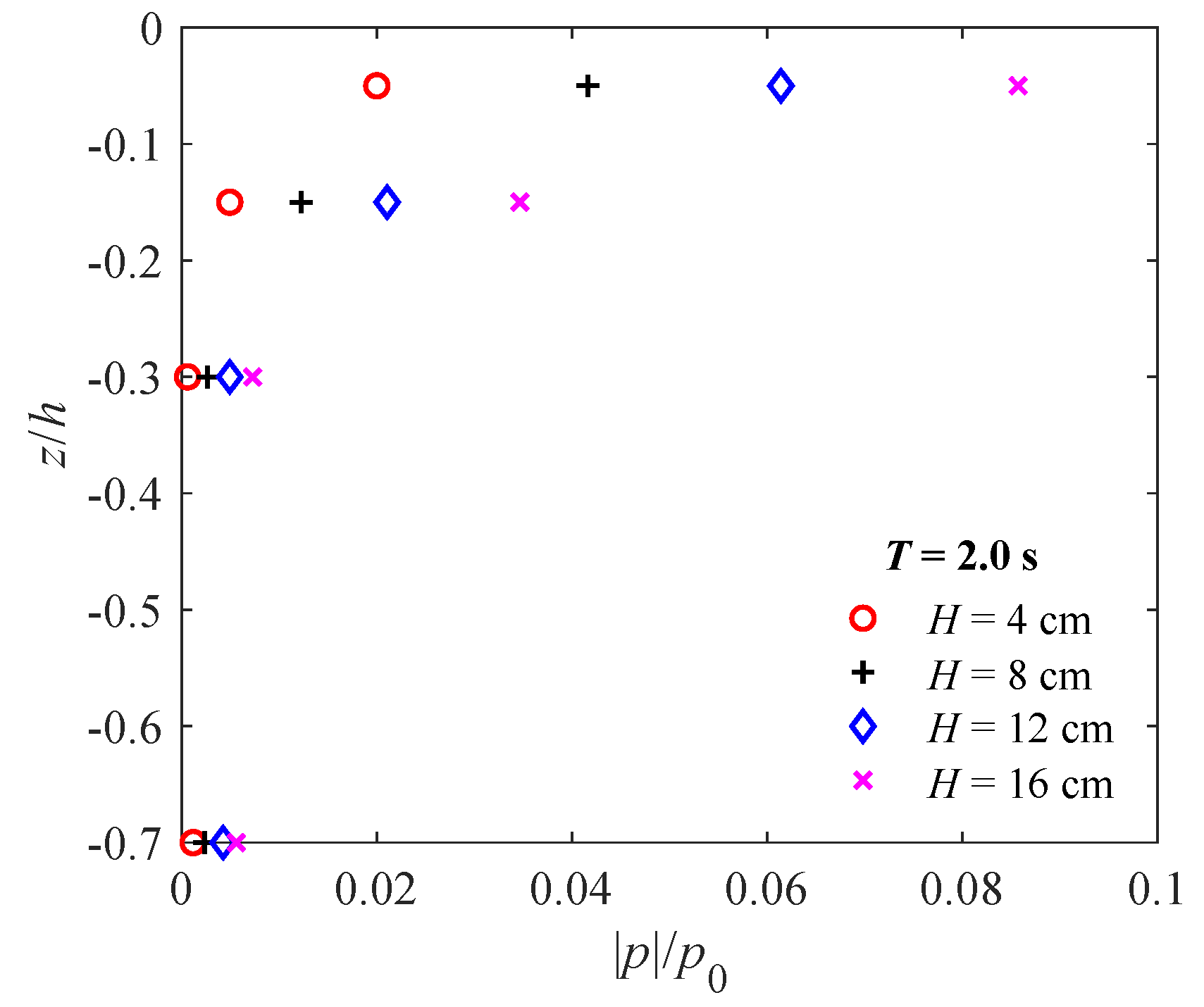
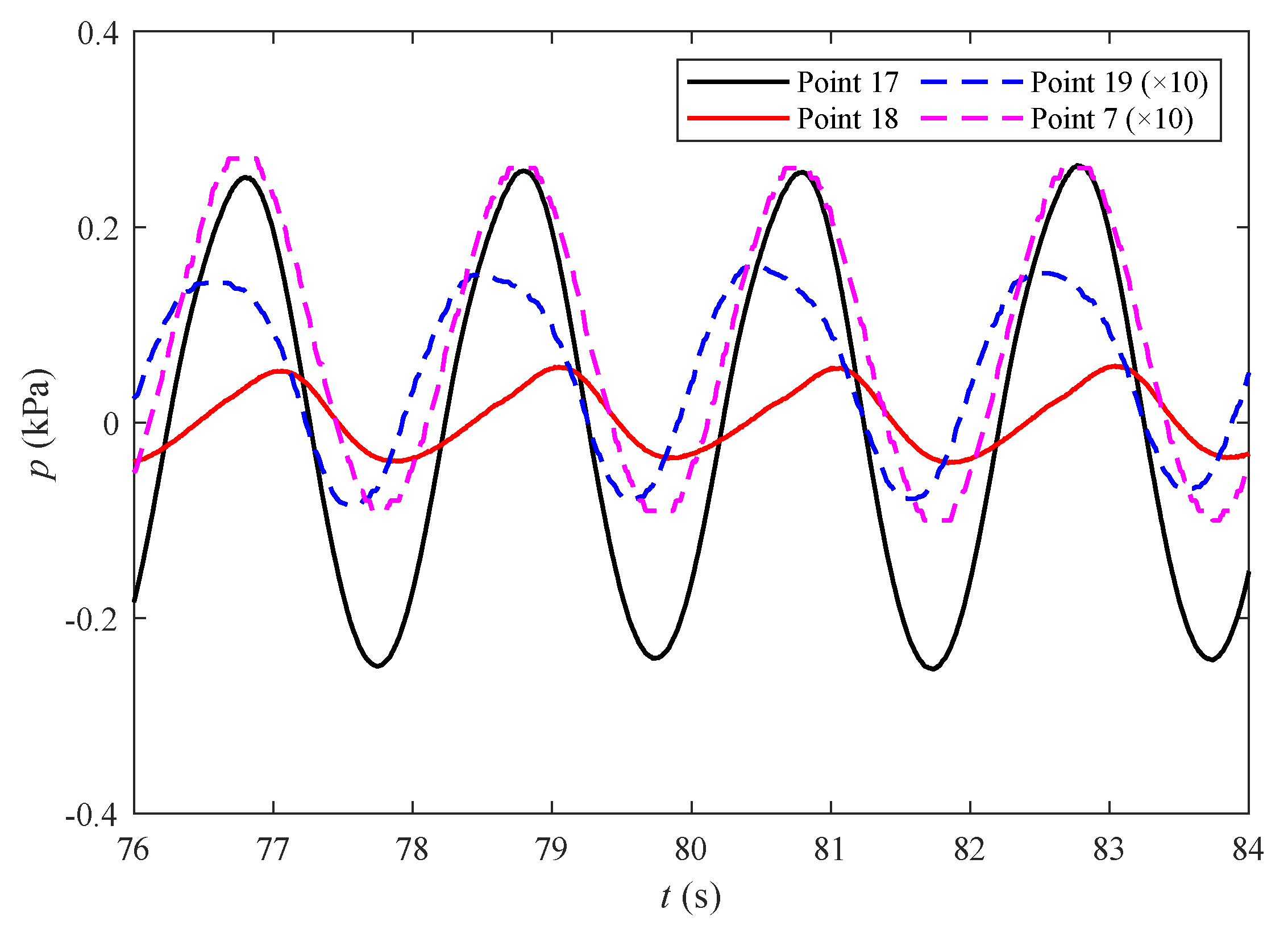
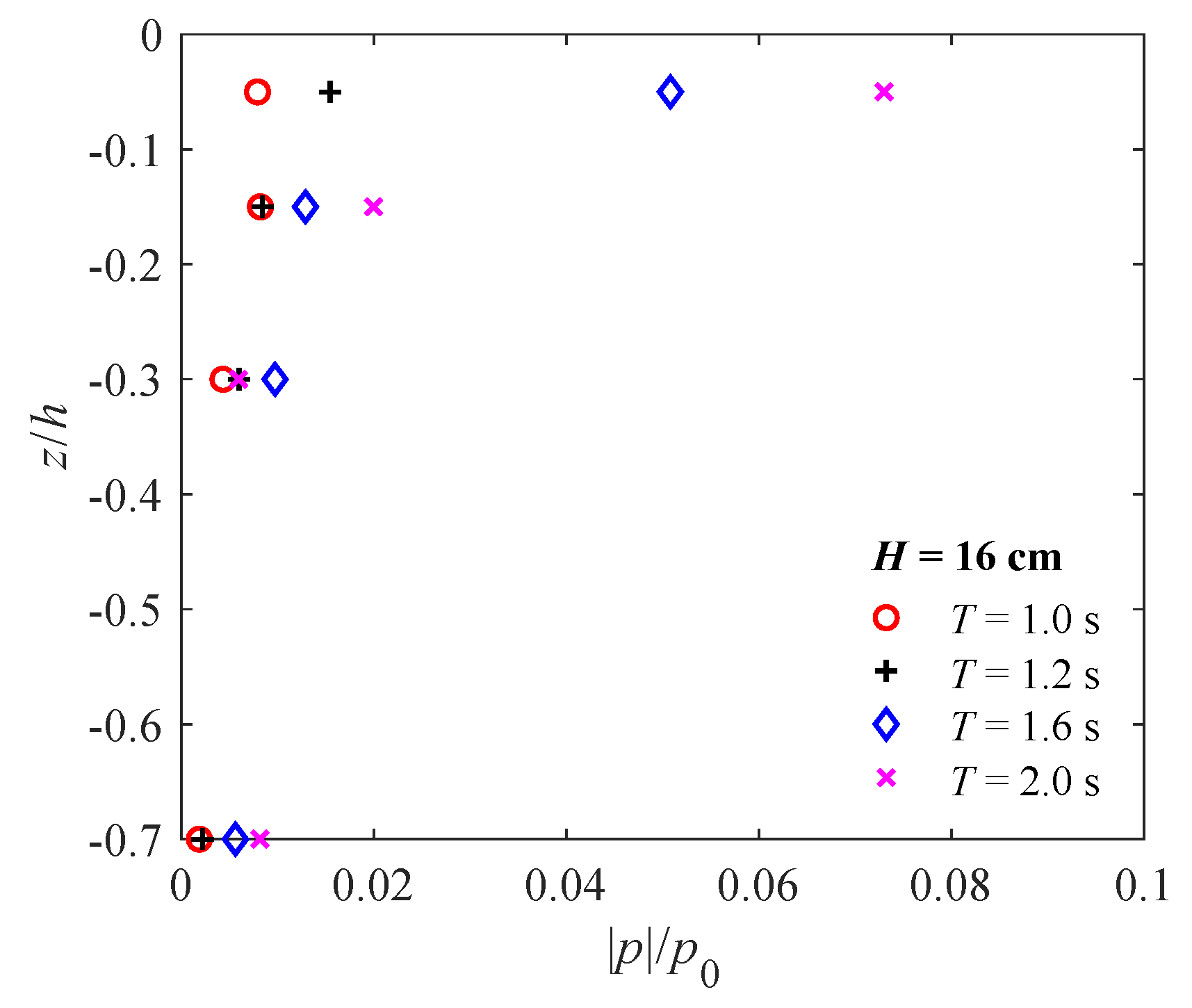



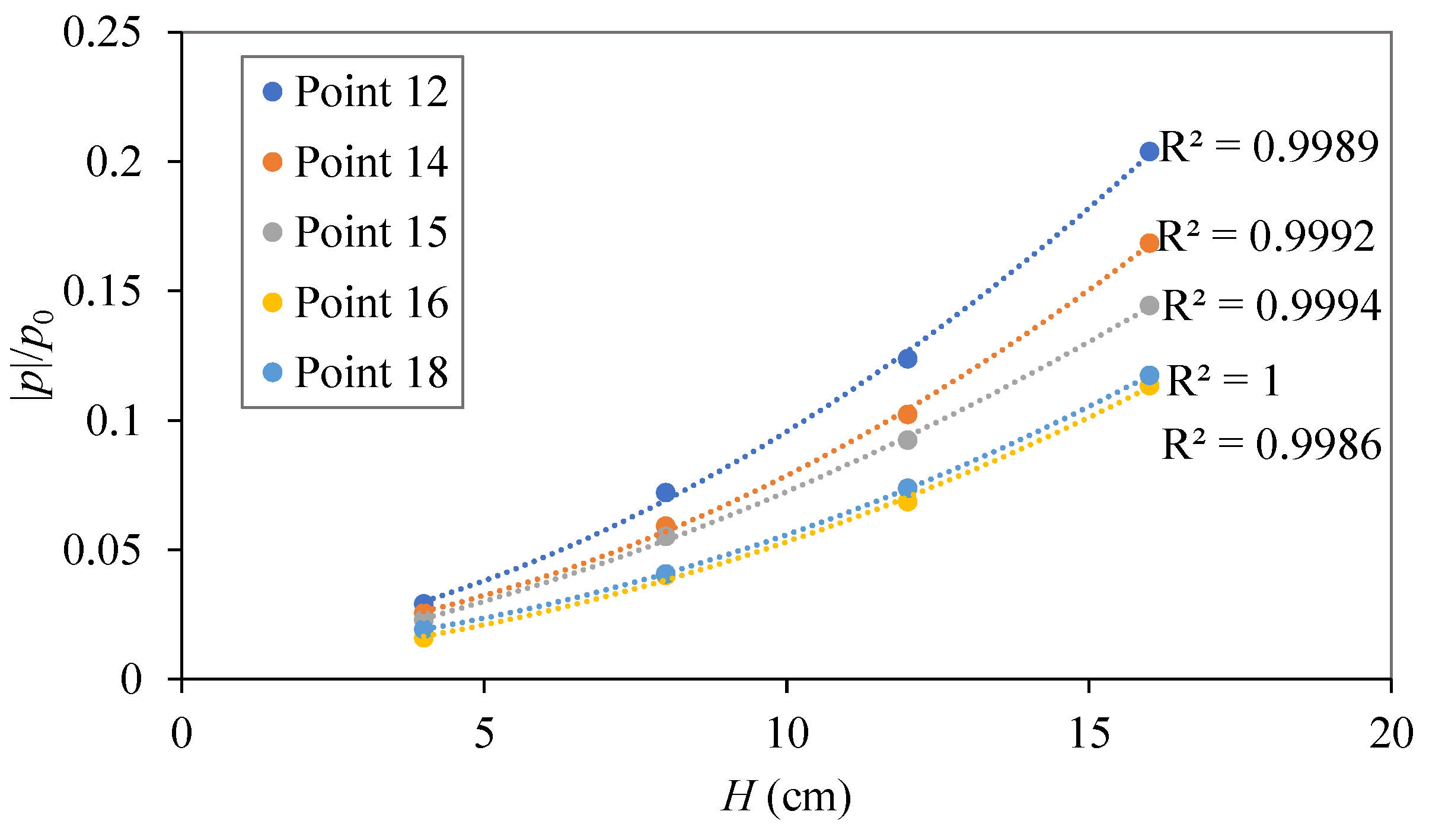
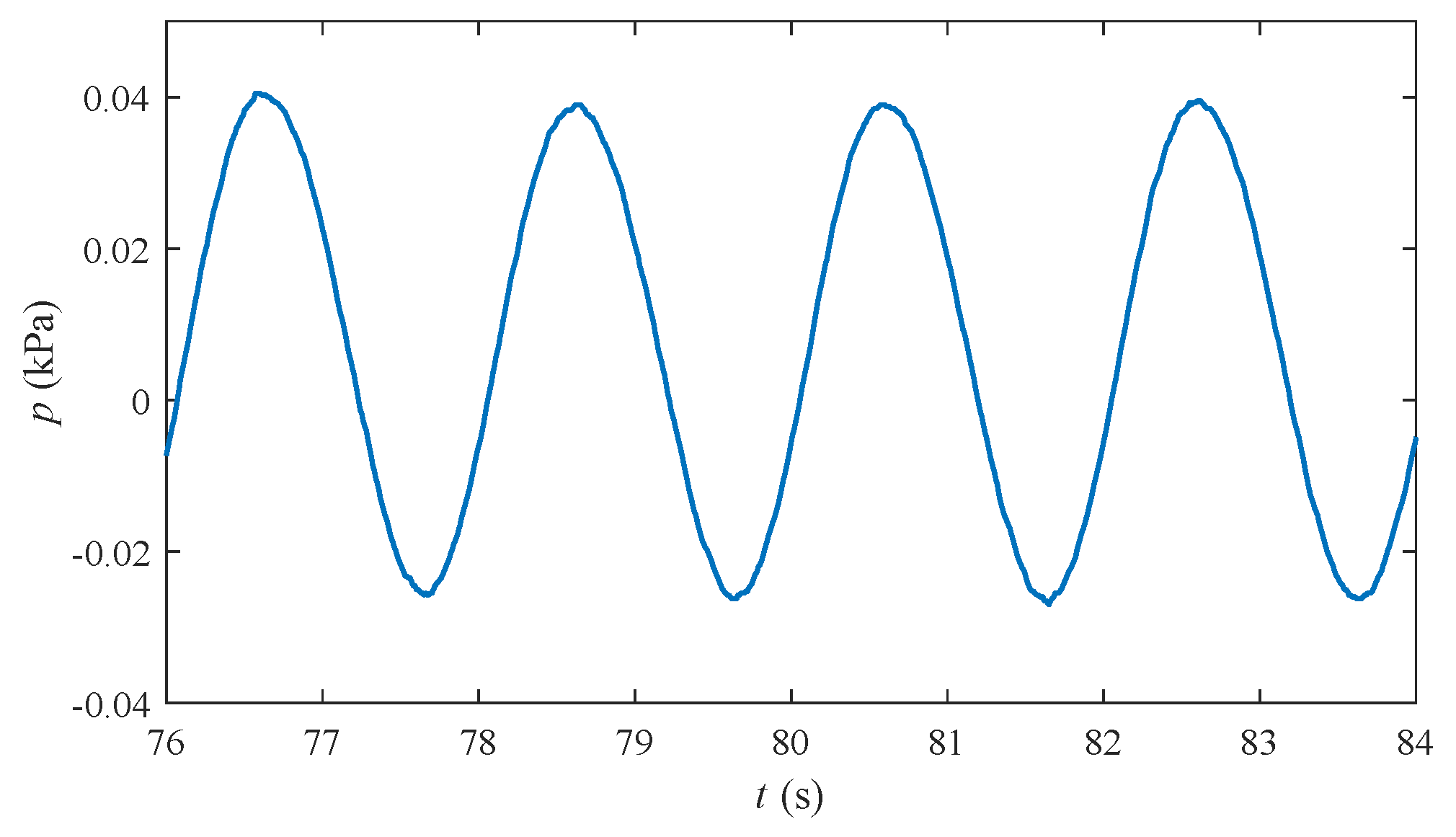
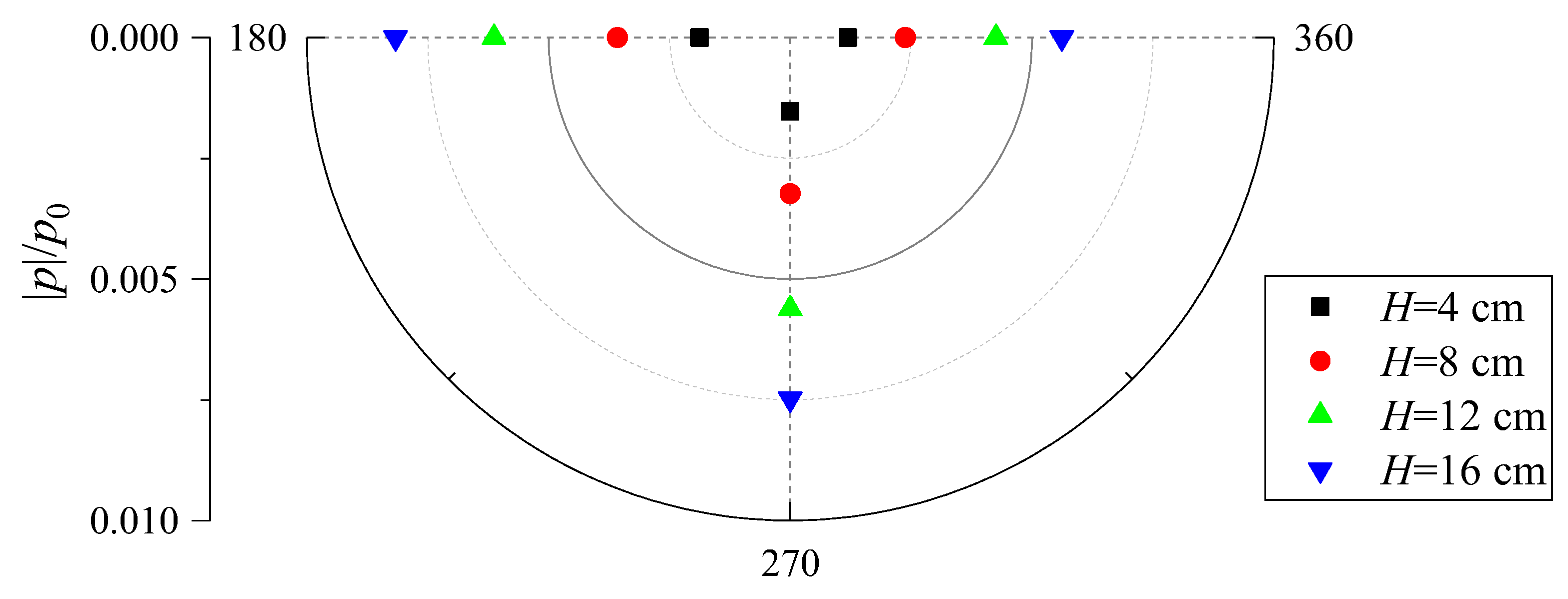

| Name | Measuring Range | Accuracy | Sampling Frequency | Type | Number |
|---|---|---|---|---|---|
| Pore-water pressure transducer | 0–30 kPa | 0.1% | 100 Hz | CY306 | 23 |
| Digital sensor hub | — | — | — | 485-20 | 2 |
| Switch | — | — | — | SG105 | 1 |
| Wave height gauge | 0–600 mm | 0.5% | 100 Hz | YWS200 | 4 |
| Name | Type |
|---|---|
| Screen | Standard Screens (2, 1, 0.5, 0.25, 0.075 mm) |
| Temperature controler | XGQ-2000 |
| Counter scale | 1 g division value |
| Volumetric flask | 100 mL |
| Permeameter | TST-70 |
| Traxial apparatus | Model TCK-1 Traxial Test Controlled Apparatus |
| Relative density test apparatus | Model JDM-1 Electric Relative density Test Apparatus |
| Soil Properties | Value | Unit |
|---|---|---|
| Grain density () | 2679 | kg/m |
| Permeability () | 2.382 ×10 | m/s |
| Shear modulus (G) | 8.58 × 10 | N/m |
| Poisson’s Ratio () | 0.3 | - |
| Soil porosity (n) | 0.448 | - |
| Void ratio (e) | 0.812 | - |
| Maximum void ratio () | 0.892 | - |
| Minimum void ratio () | 0.643 | - |
| Relative density () | 0.321 | - |
| Average grain diameter () | 0.215 | mm |
| Test No. | Wave Height | Wave Period | Test No. | Wave Height | Wave Period |
|---|---|---|---|---|---|
| (H, cm) | (T, s) | (H, cm) | (T, s) | ||
| Test 1 | 4 | 0.8 | |||
| Test 2 | 6 | ||||
| Test 3 | 8 | ||||
| Test 4 | 10 | ||||
| Test 5 | 4 | Test 26 | 4 | ||
| Test 6 | 6 | Test 27 | 6 | ||
| Test 7 | 8 | Test 28 | 8 | ||
| Test 8 | 10 | 1.0 | Test 29 | 10 | 1.6 |
| Test 9 | 12 | Test 30 | 12 | ||
| Test 10 | 14 | Test 31 | 14 | ||
| Test 11 | 16 | Test 32 | 16 | ||
| Test 12 | 4 | Test 33 | 4 | ||
| Test 13 | 6 | Test 34 | 6 | ||
| Test 14 | 8 | Test 35 | 8 | ||
| Test 15 | 10 | 1.2 | Test 36 | 10 | 1.8 |
| Test 16 | 12 | Test 37 | 12 | ||
| Test 17 | 14 | Test 38 | 14 | ||
| Test 18 | 16 | Test 39 | 16 | ||
| Test 19 | 4 | Test 40 | 4 | ||
| Test 20 | 6 | Test 41 | 6 | ||
| Test 21 | 8 | Test 42 | 8 | ||
| Test 22 | 10 | 1.4 | Test 43 | 10 | 2.0 |
| Test 23 | 12 | Test 44 | 12 | ||
| Test 24 | 14 | Test 45 | 14 | ||
| Test 25 | 16 | Test 46 | 16 |
© 2019 by the authors. Licensee MDPI, Basel, Switzerland. This article is an open access article distributed under the terms and conditions of the Creative Commons Attribution (CC BY) license (http://creativecommons.org/licenses/by/4.0/).
Share and Cite
Wang, S.; Wang, P.; Zhai, H.; Zhang, Q.; Chen, L.; Duan, L.; Liu, Y.; Jeng, D.-S. Experimental Study for Wave-Induced Pore-Water Pressures in a Porous Seabed around a Mono-Pile. J. Mar. Sci. Eng. 2019, 7, 237. https://doi.org/10.3390/jmse7070237
Wang S, Wang P, Zhai H, Zhang Q, Chen L, Duan L, Liu Y, Jeng D-S. Experimental Study for Wave-Induced Pore-Water Pressures in a Porous Seabed around a Mono-Pile. Journal of Marine Science and Engineering. 2019; 7(7):237. https://doi.org/10.3390/jmse7070237
Chicago/Turabian StyleWang, Shaohua, Pandi Wang, Hualing Zhai, Qibo Zhang, Linya Chen, Lunliang Duan, Yifei Liu, and Dong-Sheng Jeng. 2019. "Experimental Study for Wave-Induced Pore-Water Pressures in a Porous Seabed around a Mono-Pile" Journal of Marine Science and Engineering 7, no. 7: 237. https://doi.org/10.3390/jmse7070237
APA StyleWang, S., Wang, P., Zhai, H., Zhang, Q., Chen, L., Duan, L., Liu, Y., & Jeng, D.-S. (2019). Experimental Study for Wave-Induced Pore-Water Pressures in a Porous Seabed around a Mono-Pile. Journal of Marine Science and Engineering, 7(7), 237. https://doi.org/10.3390/jmse7070237






